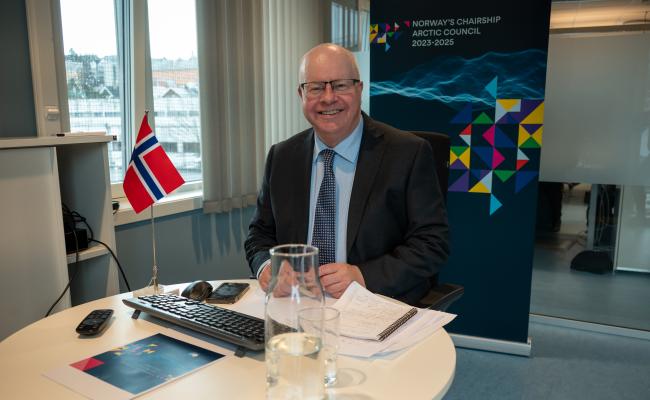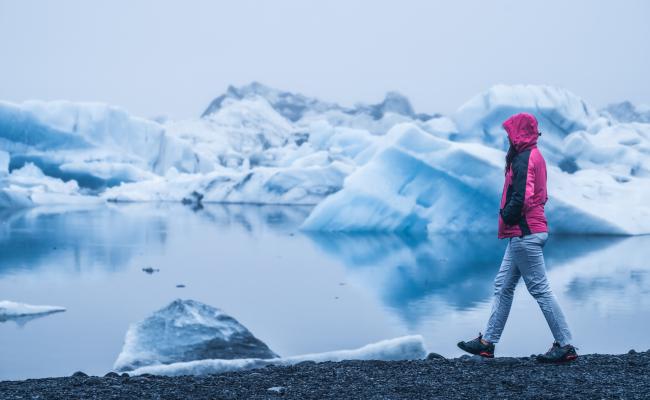Urges the Arctic Council to Show Leadership in Reducing Emissions From Shipping
SAOC Morten Høglund were celebrated at the Arctic Circle Assembly in Reykjavik for his effort to keep the Arctic Council alive. (Photo: Trine Jonassen)
In an open letter to the Norwegian Chair of the Arctic Council, the environmental foundation Bellona and the Clean Arctic Alliance urge the council to update its targets to reduce emissions of black carbon.
Dear Mr. Høglund", reads the start of the open letter to the Norwegian Chair of the Arctic Council, signed by the environmental foundation Bellona and the Clean Arctic Alliance (CAA).
The letter goes on to thank Morten Høglund for his ongoing support for action to address black carbon and methane emissions impacting the Arctic, especially during the Arctic Circle Assembly in Reykjavik, Iceland in October.
"Your efforts to raise the profile of the need to address the threat to the Arctic from black carbon emissions were very welcome".
A critical time
In May of this year the CAA outlined recommendations for safeguarding the Arctic environment, and enabling sustainable development, with a special emphasis on new measures for mitigating the impacts of Arctic shipping.
Now Bellona and the CAA says it is a critical time for the Arctic Council to show leadership leading up to the International Maritime Organization (IMO) global meeting in February 2024, to discuss black carbon reduction measures.
"Emissions from Arctic shipping have doubled in recent years. The Arctic Council now has an opportunity to steer towards concrete actions to reduce emissions of soot", says Dr Sian Prior, Lead Advisor in the Clean Arctic Alliance.
Black carbon has a disproportionately large impact.
"After 13 years of discussion at the IMO, the need for the shipping industry to act and reduce its emissions of black carbon impacting the Arctic remains urgent", the letter details.
Black Carbon and its impacts
Black carbon is a short-lived climate pollutant (SLCP), produced by the incomplete combustion of fossil fuels, with an impact of over 3000 times CO2 on a 20-year global warming potential (GWP20). When emitted near the Arctic, black carbon has a disproportionate impact.
It contributes to atmospheric warming and accelerates melting when deposited on snow and ice. The melting snow and ice exposes darker areas of land and water which absorb further heat from the sun. The reflective capacity of the planet’s polar ice cover - the albedo effect - is severely reduced.
More heat in the polar systems results in increased melting - a feedback that contributes to ‘Arctic amplification’ of climate warming. It is also an air pollutant that has a negative impact on human health including respiratory and cardiovascular diseases.
Unique ecosystems
The CAA emphasizes that the impact of black carbon on the Arctic is critical because the Arctic is a major climate regulator and is now considered by scientists to be warming as much as four times faster than the planet as a whole.
The Arctic is also an important ice habitat for wildlife – unique ecosystems supporting a huge productivity of plant and animal life in the oceans, and it is a highway and provides cultural identity for Inuit and other Indigenous Peoples.
"But we are losing Arctic sea ice - at a rate of around 13% per decade since 1979 and the older, multiyear ice is disappearing - with unprecedented consequences for the global biodiversity crisis and the loss of the Inuit homeland", states the two organizations.
"Climate change in the Arctic is more dramatic than anywhere else on the globe. Therefore, it is more important than ever to show leadership by bringing the Arctic nations together for emission reductions in shipping. Through its leadership in the Arctic Council, Norway has an important role in the world", says Sigurd Enge from Bellona.
Urgency to act
Following the release of the Intergovernmental Panel on Climate Change (IPCC) Special Report on Global Warming (of 1.5oC) in 2018, the UN Environment Programme reiterated that “fast and immediate action on SLCPs [including black carbon] can avoid a half a degree of warming by 2050 and such action will also avoid over 50% of the predicted warming in the Arctic by 2050, thereby significantly decreasing the chances of triggering dangerous climate tipping points”.
The UN Economic Commission for Europe Convention on Long Range Transboundary Air Pollution and the UN Framework Convention on Climate Change have both emphasised the threat to the Arctic and global processes from short-lived climate pollutants including black carbon.
In 2017, the Arctic Council adopted a pan-Arctic collective, aspirational goal to reduce emissions of black carbon by 25 to 33% below 2013 levels by 2025. This followed the adoption in 2015 of a framework that set The Clean Arctic Alliance.
This framework worked out a out a common vision for Arctic States to accelerate the decline in black carbon emissions and to significantly reduce methane emissions.
Also read (the article continues)
Updating the goal
Within the framework, Arctic States have committed to strengthening national actions, developing, and improving emissions inventories and emissions projections for black carbon and methane, and to submitting national reports to the Arctic Council Secretariat.
The third progress report published in 2021, announced that the Arctic States were on track to reach the collective goal of a 25 - 33% reduction in black carbon levels by 2025, and during the Arctic Council Icelandic Ministerial in 2021, Ministers committed to possibly updating the goal at the next Arctic Council Ministerial meeting.
In the letter, the CAA and Bellona presents a basket of measures to reduce black carbon emissions, including updating the Arctic Council's targets.
"Norway’s priorities and actions during its leadership of the Arctic Council between 2023 and 2025 will be critical to the future health of the Arctic Ocean", the organizations write, saying that the time to act on Black Carbon emissions from shipping is now.
The Clean Arctic Alliance urges Norway, as the current chair of the Arctic Council, to:
- Promote the development of a concrete zero-emission vision for Arctic shipping and support the development of a corresponding road-map leading to zero emissions - moving from oil based fuels to cleaner alternative non-fossil fuels and the necessary on-shore infrastructure of alternative energy, to achieve the vision.
- Encourage all Arctic nations to implement the International Maritime Organization’s (IMO) resolution MEPC.342(77) which calls for using distillate or cleaner alternative fuels in or near the Arctic.
- Call for mandatory measures at the IMO to reduce and eliminate black carbon emissions from shipping in and near the Arctic through amendment of MARPOL Annex VI to introduce a Black Carbon regulation which requires: o a mandatory switch to distillate or alternative cleaner non-fossil fuel:
- Introduction of an Arctic fuel standard based on a H/C (hydrogen/carbon) ratio threshold (to limit the aromatic content)
- A Black Carbon emission control area
- Installation of black carbon reduction technology such as diesel particulate filters.
- Call for an updated status report from Arctic states on how the implementation and fulfilment of their commitments are progressing to reduce black carbon emissions by 25 – 33% by 2025 (based on 2013 levels), and establish an immediate and ambitious process to update these targets beyond 2025 based on 1.5 degree warming pathways and the latest science and Indigenous Knowledge.
- Encourage all Arctic States to implement the Arctic heavy fuel oil (HFO) prohibition for ships operating in Arctic waters by 1 January 2024, by eliminating the use of any waivers or other loopholes which would allow HFO to be used beyond that date, and to extend the scope of the prohibition to the whole of the Arctic (Arctic Human Development Report - AHDR - definition)
- Call for the banning of Exhaust Gas Cleaning Systems (EGCS), ‘scrubbers’, and discharge of scrubber wash water in the Arctic
- Support short-term measures to reduce greenhouse gas emissions from Arctic shipping, and in particular measures to reduce ship speed, installation of wind assisted technology, and increased energy efficiency measures such as strengthening the CII (Carbon Intensity Indicator) when it is up for review in 2025.
People in the Arctic
- Supporting Indigenous Peoples to protect their livelihoods and resources through a reduction of black carbon emissions, which would slow down snow and ice melt; and the implementation of a strong HFO ban which would protect subsistence resources, such as fishing and hunting, that are essential for the food security and cultural identity of Arctic Indigenous Peoples
- Promoting efforts to ensure a just and equitable transition which directly supports Arctic Indigenous Peoples moving to cleaner alternative non-fossil fuels and making greater use of renewable energy (e.g. solar and wind power, battery storage technology) to accompany a ban on the use and carriage of HFO by ships in Arctic waters.
Cross-cutting issue
The Clean Arctic Alliance and Bellona believe that addressing emissions of black carbon from shipping impacting the Arctic is a cross-cutting issue within the framework of the Arctic Council.
They hope to meet with the Norwegian Chair during the Arctic Frontier conference in Northnern Norway in January.
"We will be attending the Arctic Frontiers Conference in Tromso and would welcome an invitation to discuss options to progress efforts within the framework of the Arctic Council and reduce black carbon emissions from shipping impacting the Arctic", the CAA and Bellona finishes.
About the Clean Arctic Alliance
Made up of 20 not-for-profit organisations, the Clean Arctic Alliance campaigns to persuade governments to take action to protect the Arctic, its wildlife and its people.
Members include: The Altai Project, Alaska Wilderness League, Bellona, Clean Air Task Force, Green Transition Denmark, Ecology and Development Foundation ECODES, Environmental Investigation Agency, Friends of the Earth US, Global Choices, Greenpeace, Iceland Nature Conservation Association, International Cryosphere Climate Initiative, Nature And Biodiversity Conservation Union, Ocean Conservancy, Pacific Environment, Seas At Risk, Surfrider Foundation Europe, Stand.Earth, Transport & Environment and WWF.





